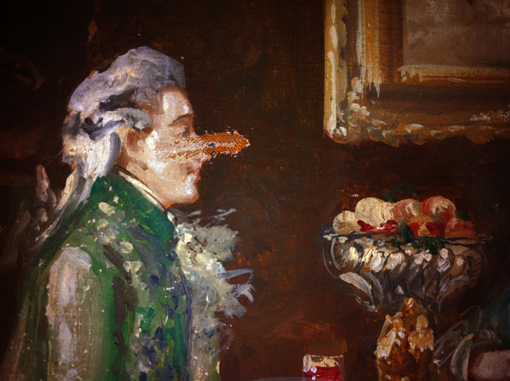A Pinocchio Story
Posted on December 23, 2010 | posted by:When I see fires, floods, earthquakes or hurricanes ripping away people’s houses I think of my horror if this ever happened to my parents’ house. My mind immediately migrates to the question “if you had to rescue one object which would it be?” The answer has remained the same year after year, catastrophe after natural catastrophe. In my parents’ house in Beirut there used to be a Romantic painting of a party of three seated at a lavishly decorated dinner table. They were two men and a woman. To the left side of the table one of the men, wrapped in a dark green overcoat and a walking stick by his right foot, was toasting to the graceful woman sitting facing him and wearing an exquisite white ball gown. What seems to be just another dinner scene produced in the Romantic Era style, was altered by the fact that the male diner had an incredibly long nose. I grew up convinced that this was the depiction of Pinocchio and used to proudly invite my friends to see it. It was not until a decade or so later that I was informed that the canvas had actually been torn by an aimless bullet that landed in our house during the civil war. The bullet went through our window, brushed past my mom’s cheek and pierced through the painting’s frame scratching the painted area in front of the diner’s nose. This came as a shock to my childhood ears but my fascination for the painting never ceased to grow.
Though not a designed object, my “relationship” with this painting always made me question the real value of our constructed environment’s components. Be it a book, a building, a chair or a fridge, there must be one quality without which a design cannot exist; possessing it, no work would become worthless.
Design constructs our physical world, most of which ends up going to waste – or hopefully recycled or reused. But what is it about some objects that induces us to save them from this dreadful end and include them in our emotional life? As I came to experience it, design’s savior is the everyday stories people construct upon it and the memories they attach to it. This may be design’s only real value and inherent ethic. How does a designer work with this knowledge in mind? I guess it’s impossible to do so but this speaks volumes about the unpredictability of our design discipline and the everyday’s constant practice of appropriating it.
My Pinocchio painting has since migrated to another location, but it still manages to draw a nostalgic smile on my face every time I come across it. Today it comes as an ironic decision that the one thing I would rescue in my house is this painting from the Romantic Era. Romanticism in the late eighteenth century prized strong emotions and memories as an authentic source of aesthetic experience!
In one of the most beautiful tributes to design, Pablo Neruda writes in Ode to Things:
many things conspired
to tell me the whole story.
Not only did they touch me,
or my hand touched them:
they were so close
that they were a part
of my being,
they were so alive with me
that they lived half my life
and will die half my death.
